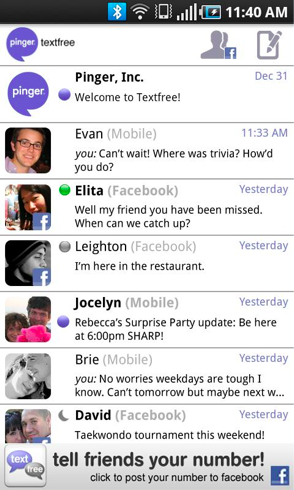
Pinger’s Textfree, the app that lets users send and receive free text messages and phone calls using real phone numbers, has a new best friend: the big green Android robot.
We’ve been tracking Textfree’s staggering growth for some time now — CEO Greg Woock says that Textfree users now exchange 1.5 billion messages and 45 million voice minutes each month, making it one of the top 10 carriers in the US. And that usage has led to some big opportunities for advertising: he says they’re closing in on 2 billion monthly ad impressions.
Textfree rose to prominence on the iPhone, but the Pinger team released a version for Android as well in February. And now, just a few months later, Android users are signing up for Textfree at the same rate as iPhone users (this ignores iPod Touch users, who make up a big chunk of the user base, but it’s still very rapid growth).
Android users are currently sending 5.5 million messages a day (and they also send 2 million messages via Facebook chat, which is integrated into the app). Growth is doubling month over month across key metrics like the number of users and messages sent. And the Android version only supports free texting — it doesn’t have the free voice calls that launched on the iPhone in December, which makes the feat all the more impressive.
Woock also discussed how Pinger’s mobile phone number strategy has worked out for them. When you sign up for Textfree you’re given a unique, real cell phone number, which means you can send and receive text messages with anyone (i.e. they don’t need to have the app). And now that the app has been out for a while, there’s a trend emerging: teenagers who used Textfree on their iPod Touch as what is essentially a VoIP phone are now starting to transition over to ‘real’ Android phones, and they’re taking their Textfree number with them.
Finally, Woock says that the company will have more news on the way very soon, including new support for international users (he didn’t get into how that will work — but he says it’s “totally unique and dead simple”).